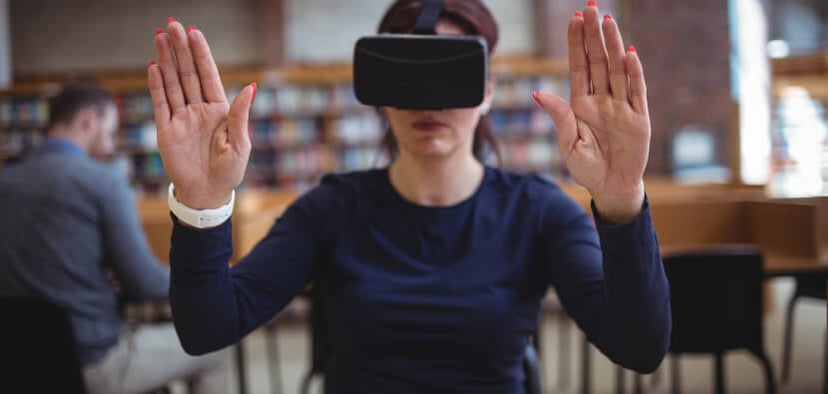In 2024, a profound transformation is underway at many libraries, driven by a surge in technological integration and the need to stay relevant and redefine their role in their communities. This wave of innovation encompasses a comprehensive approach to improving user experiences and expanding the library's impact.
From providing shelter to the homeless, digitizing historical records, and bridging the digital divide to embracing augmented reality and artificial intelligence, the public library is at the forefront of innovation. Let's take a look at the digital services and other trends shaping public libraries in 2024.
See also:
-
Digital transformation and New Year's resolutions for the modern public library
-
The future of libraries is upon us. Here’s how yours can keep pace
-
Libraries of 2024: pioneering spaces for the digital native and the lifelong learner
Digital collections and interactive resources

Continuing a long-standing trend, libraries are poised to make substantial investments in digital formats in the years to come. The digital realm has become a playground for librarians, expanding collections into vast online repositories. Patrons now have a world of digital and online resources at their fingertips, from the library catalog to digital platforms including PressReader, which provides access to thousands of newspapers and magazines from around the globe.
Virtual libraries, complete with immersive experiences like virtual reality (VR) book readings, are captivating users in new ways, too. Technology in the library is also being directed through increased investments toward video streaming services like Hoopla and Kanopy. Recent price hikes and the introduction of advertising on commercial platforms may compel patrons to seek out free, ad-free library options, providing a unique opportunity for libraries to enhance their streaming offerings.
Community-focused initiatives

Libraries across North America worked tirelessly for their communities in 2023 and will continue to do so in 2024 and beyond. Actions such as eliminating late fees, giving space to Indigenous art and languages, and launching innovative database search platforms demonstrated a commitment to meeting community needs.
In response to the surge in homelessness, Canadian public libraries expanded their roles beyond traditional services. Toronto's libraries, for instance, doubled as shelters, sparking discussions about the evolving role of libraries as critical social infrastructure. Meanwhile, UK libraries pioneered warm banks, providing warmth and resources to those unable to afford energy bills.
Many libraries are also tackling the challenge of climate change. Library and Archives Canada, along with other libraries, integrated climate-related content into their collections. The theme of sustainability permeated libraries in the UK during Libraries Week, with almost 300 activities focusing on climate change, nature and the environment and adopting environmentally sustainable technologies. This includes energy-efficient buildings, digital cataloging to reduce paper usage, recycling programs and aligning libraries with broader sustainability goals.
Online learning platforms and workshops

Libraries are also expanding their educational role by offering online courses, webinars and workshops. This commitment to lifelong learning provides patrons with opportunities to acquire new skills and stay updated on technological advancements.
Despite the proliferation of high-speed internet, the digital divide persists, particularly in rural areas. Technology in libraries took significant strides towards bridging this gap by providing free or subsidized access to the internet and computers. Initiatives like Eastern Counties Regional Library's provision of free Wi-Fi hotspot devices exemplify this commitment to ensuring digital inclusivity.
With easy access to online information, libraries also recognized the need to combat misinformation through media literacy. For example, the Public Library Association in the US organized training sessions to empower library staff and patrons in assessing online information critically.
Blockchain for library management
The integration of blockchain technology into library systems is revolutionizing how libraries manage transactions. From book loans to acquisitions and digital rights, blockchain ensures better security, traceability and transparency.
Smart contracts streamline resource-sharing agreements between libraries, making interlibrary cooperation more efficient.
Robotic assistance and automation
The library of the future might feature virtual assistants or robots efficiently handling routine tasks such as restocking shelves or guiding patrons toward the materials they need.
Harnessing the power of artificial intelligence, automation in library management systems streamlines processes, allowing staff to focus on more complex tasks while providing users with quicker access to resources.
AI-based work environment

The library workspace has moved to the cloud, with platforms like Office 365 and Google Workspace integrating AI capabilities. Staff training becomes pivotal in ensuring the effective use of conversational search tools, text-to-image generators, and large language models like ChatGPT.
Libraries are becoming key players in AI demystification, offering patrons primers on AI ethics, privacy and general understanding. Hands-on demonstrations and partnerships with experts enrich public awareness and connect the small business community with AI tech.
Augmented and virtual reality
As libraries in 2024 shift from physical repositories to hubs of digital resources, augmented reality (AR) is emerging as the next transformative library technology. The promise of AR lies in seamlessly blending the physical and digital, creating an immersive environment for patrons. Acting as a bridge between the physical and digital realms, AR breathes new life into the halls of libraries.
Libraries worldwide have embraced AR to elevate user experiences. The University of California, San Diego (UCSD) Libraries utilized AR for immersive library tours, while medical libraries, like the National Library of Medicine in the US, have leveraged AR for interactive exhibits related to medical history. Some, such as the Delft University of Technology Library in the Netherlands, showcase the power of AR in simplifying navigation. Visitors equipped with smartphones or AR glasses can effortlessly follow virtual cues, turning the exploration of vast collections into an intuitive and engaging adventure.
Practical applications of AR

AR also opens the door to a realm of educational possibilities within libraries. Virtual laboratories, created through AR, offer students immersive learning experiences. The Singapore National Library's AR program, enabling 3D exploration of the solar system, exemplifies how AR enhances traditional learning materials. In the realm of storytelling, AR marks a new chapter. Institutions like the University of Maryland Libraries in College Park utilize AR for interactive exhibits that provide additional information related to collections. Patrons can now step into the worlds of their favorite books in a unique and immersive way.
AR in libraries offers a range of benefits. Firstly, it seamlessly integrates with physical library collections, providing patrons with supplementary information during their exploration of the library. This integration enhances the overall experience and enriches the understanding of the library materials available. Moreover, AR fosters collaboration and social interaction within library spaces. By encouraging collaborative experiences, it creates a dynamic environment where library users can engage with digital content together, enhancing the social aspect of library visits.
Advantages and limitations of emerging technologies
In terms of accessibility and inclusivity, AR experiences cater to a broader audience, including individuals with disabilities. This aspect of AR contributes to promoting inclusivity within library environments, ensuring that diverse user needs are accommodated. Another notable advantage is the cost-efficiency of implementing AR. This technology can be a cost-effective solution, making it accessible even to libraries with limited budgets. This affordability opens up opportunities for a wider range of libraries to incorporate AR and provide enhanced library services to their patrons.
However, the implementation of AR in libraries comes with certain limitations. Firstly, a robust technical infrastructure is crucial for unleashing the full potential of AR. This requirement poses challenges, particularly for libraries in underserved areas that may struggle with the necessary technological resources. Additionally, creating and curating AR content demands time and expertise, necessitating strategic resource allocation. The process of developing engaging and informative AR experiences requires careful planning and execution, which may be resource-intensive.
Privacy concerns also come into play, as AR applications often collect user data. Addressing these concerns requires the establishment of transparent policies to ensure the responsible and ethical use of patron information within the AR context. Lastly, both library users and staff may require training for the effective use of AR applications. This emphasizes the need for educational initiatives to familiarize users with the technology, ensuring that they can fully benefit from the augmented experiences offered by the library.
Reinventing library services in 2024

The year 2023 was a transformative period for public libraries, marked by adaptation, community engagement and the embrace of innovative technologies.
The integration of AR, VR, AI and other technologies promises a future where the local library is not just a repository of knowledge but a dynamic hub of interactive and immersive learning experiences. The journey of reinventing public libraries in 2024 holds the promise of shaping a more engaging, inclusive and technologically advanced future for these essential community institutions.
By embracing these technology trends and innovations, libraries are cementing their position as vibrant centers of knowledge and innovation in the digital zeitgeist of 2024. Embracing change and staying at the forefront of technological advancements ensure that libraries not only survive but thrive in the ever-evolving information landscape.









